To understand the many conditions and illnesses that can affect our eyes, it is important to understand the eye itself. Knowing how the eye functions can also help you learn what to do to prevent any form of illness appearing and affecting your eyesight permanently.
There are 3 main parts to the eye: the surface of the eye, the front of the eye, and the back of the eye. Along with those main parts of the eye, there are 6 muscles on the exterior part of the eye that are attached to the eye that help to move in all directions, up and down and left and right. These muscles are called the sclera.
The Surface of The Eye
The surface of the eye and the inner surface of the eyelids is covered with this clear membrane thing called the conjunctiva which helps us move our eyelids so smoothly as well as help keep our eyes from drying out. There is then a gland called the meibomian gland that produces tears and oils that help keep our eyes clean as well as moist enough so they do not dry out. The tears move from this gland out of the tear duct onto the surface of our eye as well as around the eye socket. The tears created from this gland are also used as a lubricate for the eye and the eyelid.
The Front of The Eye
The main part of the eye that allows us to be able to see is the cornea. This part of the eye used to capture light and focus it for us to be able to see all objects in light. Behind the cornea, there is a small space filled with a liquid called aqueous humor that helps maintain the proper pressure in our eyes and is also constantly produced. To help maintain the proper eye pressure, the liquid can drain into the part of the eye called the drainage angle. The next parts are called the iris and pupil work hand in hand to capture and control the amount of light reaching the back of the eye so the eye is not damaged.
The Back of The Eye
The cavity that is between the front and the back of the eye is filled with a jelly type of substance called the vitreous humor to help the eye keep its shape. At the back of the eye, the retina absorbs almost all of the light to help us focus on the main picture of what we are looking at. The macula is then used to give us detailed vision. Then there is the peripheral retina that gives us the ability to use our peripherals to see. There are then photoreceptors in the retina that give us the ability to see color using rods and cones in our eyes. The rods are used to process black and white while the cones are used to process all forms of color. All of this information is then sent to the optic nerve for the brain to process, allowing us to see.
Contact Antelope Valley Eye Care for all of your ophthalmologist needs
If ever in need of any help with your eyes, contact this Palmdale eye doctor to help fulfill all of your needs.
